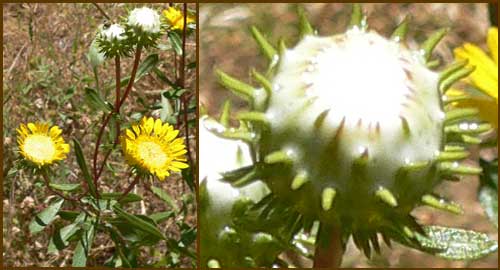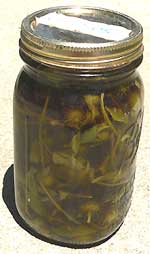
Excerpts from Jim Conrad's
Naturalist Newsletter
from the July 3, 2005 Newsletter issued from the Sierra Nevada foothills
somewhat east of Placerville, California, USA
GUMWEED & POISON OAK
One of those many, very pretty composites adorning our slopes now is the Gumweed, GRINDELIA HIRSUTULA. Though common and almost weedlike it does something I've not seen other plants do.
First, on stems four to seven feet tall it produces clusters of green, spherical flower buds about the size of quarters. The buds' scales (involucral bracts) end in outwardly flaring, spinelike tips that might dissuade a browsing herbivore. The unusual thing, however, is that at the bud's very top there's always a sizable gob of very sticky, white latex, like milkweed milk. This gummy stuff keeps out bugs that might otherwise enter the bud and eat the all-important, tiny composite flowers. When the flower finally opens, the youngest immature flowers remain safely immersed in latex. Only when they mature to the point that they need pollinators to visit does the latex disappear, leaving normal- looking, dry flowers. You can see all this in a photo I took near my trailer below:

 When I saw this I had to go tell Fred. Of course he knew all about it, plus he informed me that he and Diana clip those gummy heads, put them into jars, pour alcohol over them and, once the alcohol turns dark green, the lotion is used as a treatment for Poison Oak. I can't test it because I'm not allergic, but it seems to work on others. You can see a jar of it Diana fixed up at the right.
When I saw this I had to go tell Fred. Of course he knew all about it, plus he informed me that he and Diana clip those gummy heads, put them into jars, pour alcohol over them and, once the alcohol turns dark green, the lotion is used as a treatment for Poison Oak. I can't test it because I'm not allergic, but it seems to work on others. You can see a jar of it Diana fixed up at the right.